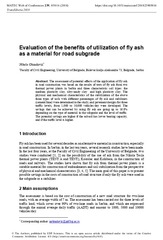| dc.creator | Obradović, Nikola | |
| dc.date.accessioned | 2019-04-19T14:28:57Z | |
| dc.date.available | 2019-04-19T14:28:57Z | |
| dc.date.issued | 2018 | |
| dc.identifier.issn | 2261-236X | |
| dc.identifier.uri | https://grafar.grf.bg.ac.rs/handle/123456789/911 | |
| dc.description.abstract | The assessment of potential effects of the application of fly ash in road construction was based on the results of tests of fly ash from two thermal power plants in Serbia and three characteristic soil types: The medium plasticity clay, silty-sandy clay and high plasticity clay. The physical and mechanical characteristics of the stabilization of the above three types of soils with different percentages of fly ash and stabilizers (cement/lime) were determined in the study, and pavement designs for three traffic levels, from 1,000 to 10,000 vehicles/day were developed. The savings that can be achieved by using fly ash are going up to 16.8% depending on the type of material in the subgrade and the level of traffic. The potential savings are higher if the subsoil has lower bearing capacity, and if the traffic level is higher. | en |
| dc.publisher | EDP Sciences | |
| dc.relation | Electric Power Industry of Serbia, “The use of fly ash of thermal power plants on soil stabilization, self-placing and rolled concrete (RSS) with a discussion on the durability of cement mortars and fine-grained concrete” | |
| dc.rights | openAccess | |
| dc.rights.uri | https://creativecommons.org/licenses/by/4.0/ | |
| dc.source | MATEC Web of Conferences | |
| dc.title | Evaluation of the benefits of utilization of fly ash as a material for road subgrade | en |
| dc.type | conferenceObject | |
| dc.rights.license | BY | |
| dc.citation.other | 239: - | |
| dc.citation.volume | 239 | |
| dc.identifier.doi | 10.1051/matecconf/201823905016 | |
| dc.identifier.fulltext | https://grafar.grf.bg.ac.rs//bitstream/id/4272/909.pdf | |
| dc.identifier.scopus | 2-s2.0-85058457369 | |
| dc.type.version | publishedVersion | |

